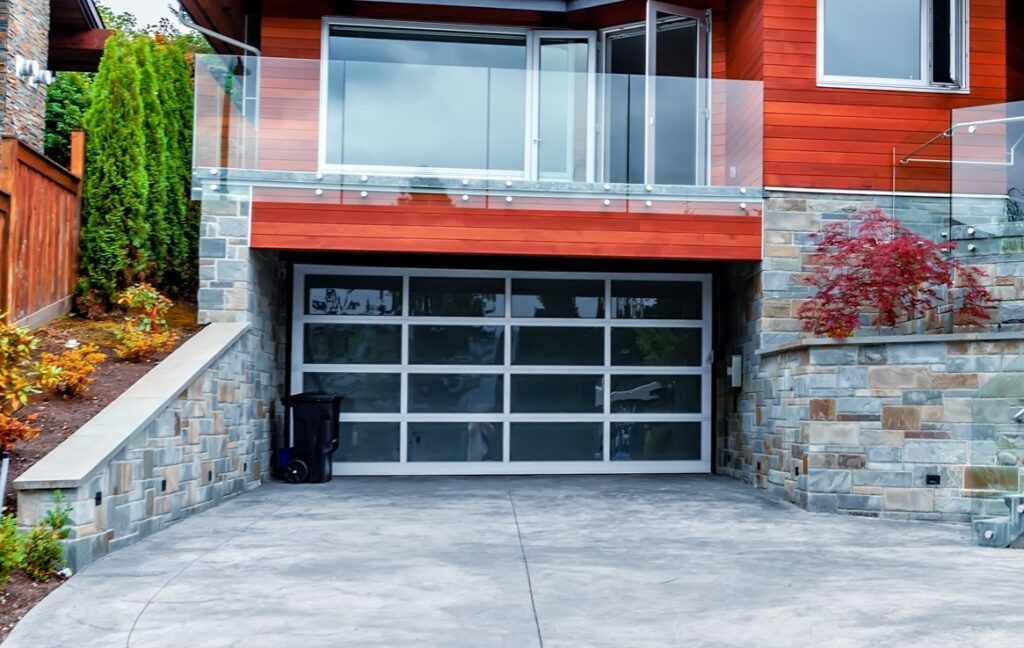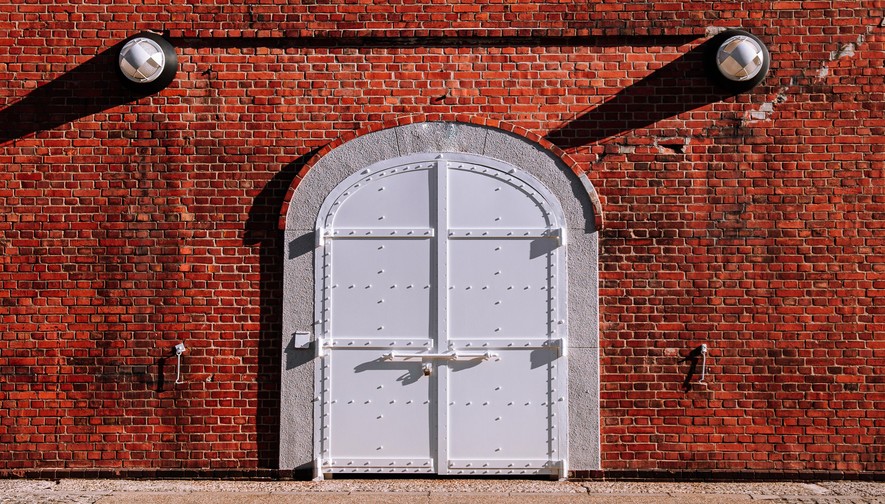Of all the features, the garage door can make up to 50 percent of the front of the home. As such, the look of your garage door can play a major part in the house’s curb appeal. While most garage doors blend into the rest of the house, unusual colors or unexpected designs can really make a home stand out.

The first garage doors were, for the most part, barn doors. After all, automobiles were on the scene well before garages were. Barns, however, were ready-made spaces for the new-fangled contraptions at the beginning of the 20th century with their large swinging doors and plenty of room.
As vehicles became more established, unattached barns gave way to garages attached to the home. These were called carriage houses and their doors were essentially smaller, more ornate barn doors. Through the decades, garage door styles, mechanisms, and materials changed.
Today, garage doors can be opened with technology that didn’t even exist a few years ago. Doors are more secure, easier to open, and even energy-efficient. Of course, one thing hasn’t changed during all this time: carriage house doors are still a very stylized way to keep your car secure.
Different Types of Garage Doors
As the times changed, so did garage doors. Cars got bigger and garage doors had to follow suit. Technology improved, materials changed, and automation started playing a part in how we opened and closed our garage doors. The following are the most common examples of garage doors and a look at how they evolved.
Swing Out Doors – Like the barn doors of yore, swing-out doors are essentially double doors that open up like french doors to your home. They are usually ornate with eye-catching hardware. In some cases, they can be rounded at the top. There are garage door openers designed to work with these doors, so you don’t need to get out of your car to open them.
Tilt-Up Doors – Popular in the middle of the last century, these doors were essentially one panel. These doors have a handle at the bottom of the door and the whole door “tilts up” and moves back into the garage. Because there were no SUVs at the time, tilt-up doors were relatively small and easy to handle, although tension springs help with the movement.
Sectional Doors – Unlike tilt-up doors, these overhead doors are made up of panels that run on tracks along the opening of the garage and the ceiling of the garage. Much heavier than tilt-up doors, the tension springs are much bigger to help with the added weight. These doors are the most common in the U.S. today, but designs can be anything but pedestrian.
Roll-Up Doors – Most commonly seen in commercial, manufacturing, or industrial situations, roll-up doors don’t run along tracks like the sectional doors, but rather roll up at the top of the garage door opening. The sections of these doors are much shorter than in residential homes and usually made of metal, are heavy-duty, yet still lightweight.

Folding Doors – As the most modern option, folding doors aren’t very common. But they can be pretty cool looking. These doors can either fold up and down or side-to-side, similar to closet or pantry doors. These doors are built for custom applications and really add a “wow” factor to any home.
Garage Door Materials
At the start, most garage doors were made from wood. It was a plentiful resource, easy to work with, and lighter than other options. As other materials became more available, customizable, and lighter, the makeup of a garage door changed. While you still see wood garage doors in residential neighborhoods, these are holdovers from several decades ago.
Wood Garage Doors – As explained above, wood garage doors were the standard for many years. Swing-out, tilt-up, and sectional doors were all made with wood. They could be very ornate, painted or stained any color, and when properly maintained, very durable. Because the look of wood is warm and inviting, it is still a popular choice for many when it comes to garage doors.
Steel Garage Doors – The first steel doors were used in industrial situations, storage, and just overall security. Resistant to fire and very strong, steel doors have found their way to suburbs as they can be made much lighter than wood. They don’t rot like wood and stand up to the elements much better. Because of that, they are easier to maintain.
Aluminum Garage Doors – Lighter than wood and steel, aluminum frames and doors are still quite durable. It doesn’t warp like wood can and won’t rust like steel. These doors are virtually maintenance-free and won’t stress the garage hardware as much as the other two materials. They are very customizable, too, and can be made to have a wood-grain appearance. However, aluminum doors are also more susceptible to dents and dings.
Vinyl Garage Doors – Highly customizable, vinyl doors can be made to look like almost anything. When it comes to maintenance, these doors never need re-painting because they are made to be a certain color. A simple washing is all that’s needed to bring them back to their original glory. They won’t rot, rust, or degrade no matter the climate.
Foam Insulation
Today, garages are used for much more than keeping the car out of the elements. They are used for garden tools, holiday decorations, and sports equipment storage. Home offices, workout areas, and home-based businesses. Some homeowners even turn the area into “man caves” to watch sports, play pool, or just somewhere to relax.

The garage is much more than an unfinished area of the home with a concrete floor. Garage door construction has taken these trends into account. By adding insulation to the door, these large drafty areas are now becoming more energy efficient.
In most cases, foam insulation is used with wood, aluminum, and vinyl garage doors. The insulation is either injected into the cavity of the panel or insulation foam board is added during construction. There are doors that can reach an R-value of up to 16, which reaches code for exterior walls in some areas.
Of course, that energy efficiency is lost every time the door is open. But if it remains closed for days at a time, these doors can keep your tv-watching, music-listening, or arts and crafting activities nice and comfortable.
Garage Door Designs
Just like the front entry door to your home, garage doors can be as stylized as you want. Depending on the architecture of your home – and your budget – garage doors can be made to match any era of design. Google “garage door designs” and almost one billion results will show up.

From the hardware to the number of windows to the shape, almost any garage door can be made to exacting tastes. Hinges and handles can be mid-century or medieval. Glass can be clear, frosted, and even insulated. There are hundreds of colors to choose from and some homeowners even paint murals on their doors.
If you’re considering a home improvement project to change up the look of your home, a custom-built garage door may be the easiest way to do it. Replacing a wood sectional garage door with a fold-up frosted glass door will make an immediate impact. Of course, you still need to consider if that option will fit with the rest of the home.
Trying to figure out if your garage door needs an update or an upgrade? Did a second of distraction lead to a broken garage door? Or is your garage door just making noises it shouldn’t? Contact Ponderosa Garage Doors and see how we can help.
